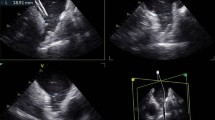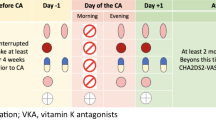Abstract
Aim
The aim of this study was to analyze the radiation usage in patients undergoing pulmonary vein isolation (PVI) in Germany and to evaluate the possibility to reduce radiation dose.
Methods and results
A total of 6617 patients with atrial fibrillation (AF) from the German ablation registry and the FREEZEplus registry (control group), who underwent first PVI between 2007 and 2014, were analyzed. In the second step, the effect of optimized conventional fluoroscopy and optimized 3D mapping use was evaluated in 526 consecutive patients with AF who underwent first PVI at the Klinikum Ludwigshafen (optimized group) between 2007 and 2014. In the control group, the median dose area product (DAP) for PVI was 34 Gy cm2, and the median DAP rate was 1.3 Gy cm2/min. The DAP decreased from 37 to 28 Gy cm2, whereas the DAP rate increased from 1.3 to 1.6 Gy cm2/min between 2007 and 2014. In the optimized group, optimized radiation application and use of 3D mapping resulted in a continuous decrease in the DAP from 67 to 2 Gy cm2 and DAP rate from 1.0 to 0.2 Gy cm2/min.
Conclusion
Currently, the median radiation exposure during PVI in Germany is 28 Gy cm2. Optimized fluoroscopy by simple means can safely reduce the radiation dose to about 2 Gy cm2 or even lower when using 3D mapping. Before introducing novel expensive technologies for radiation reduction optimizing of the conventional fluoroscopy is mandatory.
Similar content being viewed by others
References
Sun Z, AbAziz A, Yusof AK (2013) Radiation-induced noncancer risks in interventional cardiology: optimisation of procedures and staff and patient dose reduction. Biomed Res Int. 2013:976962
Mettler FA Jr, HudaW Yoshizumi TT, Mahesh M (2008) Effective doses in radiology and diagnostic nuclear medicine: a catalog. Radiology 248:254–263
Mettler FA Jr, Bhargavan M, Faulkner K, Gilley DB, Gray JE, Ibbott GS, Lipoti JA, Mahesh M, McCrohan JL, Stabin MG, Thomadsen BR, Yoshizumi TT (2009) Radiologic and nuclear medicine studies in the United States and worldwide: frequency, radiation dose, and comparison with other radiation sources—1950–2007. Radiology 253:520–531
Picano E (2004) Sustainability of medical imaging. Education and debate. BMJ 328:578–580
Roguin A, Goldstein J, Bar O, Goldstein JA (2013) Brain and neck tumors among physicians performing interventional procedures. Am J Cardiol 111:1368–1372
Schmidt M, Dorwarth U, Andresen D, Brachmann J, Kuck KH, Kuniss M, Lewalter T, Spitzer S, Willems S, Senges J, Jünger C, Hoffmann E (2014) Cryoballoon versus RF ablation in paroxysmal atrial fibrillation: results from the German Ablation Registry. J Cardiovasc Electrophysiol 25:1–7
Straube F, Dorwarth U, Vogt J, Kuniss M, Heinz Kuck K, Tebbenjohanns J, Garcia Alberola A, Chun KR, Souza JJ, Ouarrak T, Senges J, Brachmann J, Lewalter T, Hoffmann E (2014) Differences of two cryoballoon generations: insights from the prospective multicentre, multinational FREEZE Cohort Substudy. Europace 16:1434–1442
Ullah W, McLean A, Hunter RJ, Baker V, Richmond L, Cantor EJ, Dhinoja MB, Sporton S, Earley MJ, Schilling RJ (2014) Randomized trial comparing robotic to manual ablation for atrial fibrillation. Heart Rhythm 11:1862–1869
Malmborg H, Lönnerholm S, Blomström P, Blomström-Lundqvist C (2013) Ablation of atrial fibrillation with cryoballoon or duty-cycled radiofrequency pulmonary vein ablation catheter: a randomized controlled study comparing the clinical outcome and safety; the AF-COR study. Europace 15:1567–1573
Makimoto H, Heeger CH, Lin T, Rillig A, Metzner A, Wissner E, Mathew S, Deiss S, Rausch P, Lemeš C, Kuck KH, Ouyang F, Tilz RR (2015) Comparison of contact force-guided procedure with non-contact force-guided procedure during left atrial mapping and pulmonary vein isolation: impact of contact force on recurrence of atrial fibrillation. Clin Res Cardiol. 104:861–870
Walters TE, Kistler PM, Morton JB, Sparks PB, Halloran K, Kalman JM (2012) Impact of collimation on radiation exposure during interventional electrophysiology. Europace 14:1670–1673
De Buck S, La Gerche A, Ector J, Wielandts JY, Koopman P, Garweg C, Nuyens D, Heidbuchel H (2012) Asymmetric collimation can significantly reduce patient radiation dose during pulmonary vein isolation. Europace 14:437–444
Schneider R, Lauschke J, Schneider C, Tischer T, Glass A, Bänsch D (2015) Reduction of radiation exposure during ablation of atrial fibrillation. Herz. 40(6):883–891
Rolf S, John S, Gaspar T, Dinov B, Kircher S, Huo Y, Bollmann A, Richter S, Arya A, Hindricks G, Piorkowski C, Sommer P (2013) Catheter ablation of atrial fibrillation supported by novel nonfluoroscopic 4D navigation technology. Heart Rhythm 10:1293–1300
Christoph M, Wunderlich C, Moebius S, Forkmann M, Sitzy J, Salmas J, Mayer J, Huo Y, Piorkowski C, Gaspar T (2015) Fluoroscopy integrated 3D mapping significantly reduces radiation exposure during ablation for a wide spectrum of cardiac arrhythmias. Europace 17:928–937
Sommer P, Rolf S, Piorkowski C, Gaspar T, Huo Y, Piedra C, Richter S, Bollmann A, Arya A, Hindricks G (2014) Nonfluoroscopic catheter visualization in atrial fibrillation ablation: experience from 375 consecutive procedures. Circ Arrhythm Electrophysiol 7:869–874
Huo Y, Christoph M, Forkmann M, Pohl M, Mayer J, Salmas J, Sitzy J, Wunderlich C, Piorkowski C, Gaspar T (2015) Reduction of fluoroscopy exposure during atrial fibrillation ablation using a novel fluoroscopy image integrated 3-dimensional electroanatomical mapping system: a prospective, randomized, single-blind, and controlled study. Heart Rhythm 12:1945–1955
Calkins H, Brugada J, Packer DL, Cappato R, Chen SA, Crijns HJ, Damiano RJ Jr, Davies DW, Haines DE, Haissaguerre M, Iesaka Y, Jackman W, Jais P, Kottkamp H, Kuck KH, Lindsay BD, Marchlinski FE, McCarthy PM, Mont JL, Morady F, Nademanee K, Natale A, Pappone C, Prystowsky E, Raviele A, Ruskin JN, Shemin RJ; Heart Rhythm Society; European Heart Rhythm Association; European Cardiac Arrhythmia Society; American College of Cardiology; American Heart Association; Society of Thoracic Surgeons (2007) HRS/EHRA/ECAS expert consensus statement on catheter and surgical ablation of atrial fibrillation: recommendations for personnel, policy, procedures and follow-up. A report of the Heart Rhythm Society (HRS) Task Force on Catheter and Surgical Ablation of Atrial Fibrillation developed in partnership with the European Heart Rhythm Association (EHRA) and the European Cardiac Arrhythmia Society (ECAS); in collaboration with the American College of Cardiology (ACC), American Heart Association (AHA), and the Society of Thoracic Surgeons (STS). Endorsed and approved by the governing bodies of the American College of Cardiology, the American Heart Association, the European Cardiac Arrhythmia Society, the European Heart Rhythm Association, the Society of Thoracic Surgeons, and the Heart Rhythm Society. Europace 9:335–79
Wakili R, Clauss S, Schmidt V, Ulbrich M, Hahnefeld A, Schüssler F, Siebermair J, Kääb S, Estner HL (2014) Impact of real-time contact force and impedance measurement in pulmonary vein isolation procedures for treatment of atrial fibrillation. Clin Res Cardiol 103:97–106
Rillig A, Lin T, Schmidt B, Feige B, Heeger C, Wegner J, Wissner E, Metzner A, Arya A, Mathew S, Wohlmuth P, Ouyang F, Kuck KH, Tilz RR (2016) Experience matters: long-term results of pulmonary vein isolation using a robotic navigation system for the treatment of paroxysmal atrial fibrillation. Clin Res Cardiol 105:106–116
Metzner A, Heeger CH, Wohlmuth P, Reißmann B, Rillig A, Tilz RR, Mathew S, Lemes C, Deiß S, Maurer T, Saguner A, Ouyang F, Kuck KH, Wißner E (2016) Two-year outcome after pulmonary vein isolation using the second-generation 28-mm cryoballoon: lessons from the bonus freeze protocol. Clin Res Cardiol 105:72–78
Proietti R, Pecoraro V, Di Biase L, Natale A, Santangeli P, Viecca M, Sagone A, Galli A, Moja L, Tagliabue L (2013) Remote magnetic with open-irrigated catheter vs. manual navigation for ablation of atrial fibrillation: a systematic review and meta-analysis. Europace. 15:1241–1248
Compagnone G, Ortolani P, Domenichelli S, Ovi V, Califano G, Dall’Ara G, Marzocchi A (2011) Effective and equivalent organ doses in patients undergoing coronary angiography and percutaneous coronary intervention. Med Phys 38:2168–2175
Dekker LR, van der Voort PH, Simmers TA, Verbeek XA, Bullens RW, Veer MV, Brands PJ, Meijer A (2013) New image processing and noise reduction technology allows reduction of radiation exposure in complex electrophysiologic interventions while maintaining optimal image quality: a randomized clinical trial. Heart Rhythm 10:1678–1682
Ruisi CP, Brysiewicz N, Asnes JD, Sugeng L, Marieb M, Clancy J, Akar JG (2013) Use of intracardiac echocardiography during atrial fibrillation ablation. Pacing Clin Electrophysiol 36:781–788
Mah DY, Miyake CY, Sherwin ED, Walsh A, Anderson MJ, Western K, Abrams DJ, Alexander ME, Cecchin F, Walsh EP, Triedman JK (2014) The use of an integrated electroanatomic mapping system and intracardiac echocardiography to reduce radiation exposure in children and young adults undergoing ablation of supraventricular tachycardia. Europace 16:277–283
Siklódy CH, Minners J, Allgeier M, Allgeier HJ, Jander N, Keyl C, Weber R, Schiebeling-Römer J, Kalusche D, Arentz T (2010) Pressure-guided cryoballoon isolation of the pulmonary veins for the treatment of paroxysmal atrial fibrillation. J Cardiovasc Electrophysiol 21:120–125
Acknowledgments
The German ablation registry and the FREEZE trial were supported by the Institut für Herzinfarktforschung, Ludwigshafen, Germany. Medtronic funded the FREEZE trial.
Author information
Authors and Affiliations
Corresponding author
Ethics declarations
Conflict of interest
Dr. Kleemann has nothing to disclose. Prof. Dr. Brachmann reports grants and personal fees from Medtronic during the conduct of the study; grants from Medtronic and from St. Jude outside the submitted work. Prof. Dr. Lewalter has nothing to disclose. Prof. Dr. Andresen has nothing to disclose. Prof. Dr. Willems reports personal fees from St. Jude Medical, Biosense Webster, Boston Scientific, Bristol Myers Squibb, Sanofi Aventis, Boehringer Ingelheim and Bayer. Prof. Dr. Spitzer reports personal fees from Medtronic, Recordati Pharma, Topera, AstraZeneca, St. Jude Medical, Biosense Webster, Bristol Myer Squibb, and Bayer Vital, outside the submitted work. Prof. Dr. Hoffmann reports grants from Biotronik SE & CoKG, Edwards Corp., Medtronic GmbH, Philips GmbH, Jude Medical GmbH, B. Braun AG, and Stentys Inc, personal fees from Bayer, Boehringer Ingelheim GmbH & CoKG, Boston Scientific, MSD Sharp & Dohme GMBH, and Astra Zeneca, outside the submitted work. Prof. Dr. Eckardt has nothing to disclose. Dr. Hochadel has nothing to disclose. Prof. Dr. Senges reports grants from Medtronic for the conduct of the Freezeplus Study. Prof. Dr. Kuck reports grants and personal fees from St. Jude Medical, grants and personal fees from Biosense Webster, grants and personal fees from Medtronic, outside the submitted work. Prof. Dr. Seidl reports grants from St. Jude Medical and Medtronic, during the conduct of the study; personal fees from St. Jude Medical, Medtronic, Bayer, Pfizer, and Boehringer Ingelheim, outside the submitted work. Prof. Dr. Zahn has nothing to disclose.
Rights and permissions
About this article
Cite this article
Kleemann, T., Brachmann, J., Lewalter, T. et al. Development of radiation exposure in patients undergoing pulmonary vein isolation in Germany between 2007 and 2014: great potential to minimize radiation dosage. Clin Res Cardiol 105, 858–864 (2016). https://doi.org/10.1007/s00392-016-0994-9
Received:
Accepted:
Published:
Issue Date:
DOI: https://doi.org/10.1007/s00392-016-0994-9




